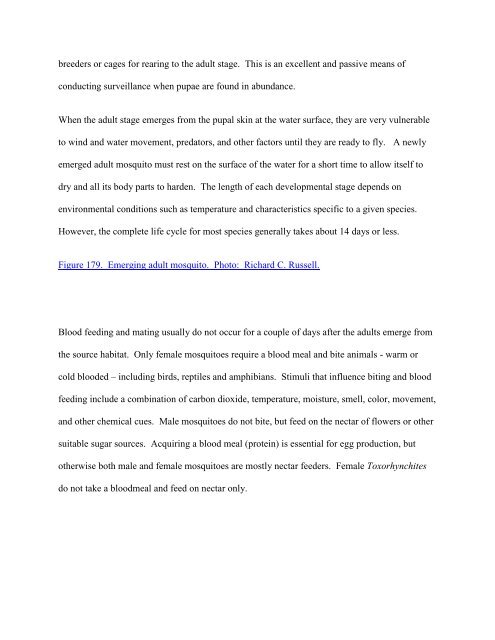Field Guide to Venomous and Medically Important Invertebrates ...
Field Guide to Venomous and Medically Important Invertebrates ...
Field Guide to Venomous and Medically Important Invertebrates ...
Create successful ePaper yourself
Turn your PDF publications into a flip-book with our unique Google optimized e-Paper software.
eeders or cages for rearing <strong>to</strong> the adult stage. This is an excellent <strong>and</strong> passive means of<br />
conducting surveillance when pupae are found in abundance.<br />
When the adult stage emerges from the pupal skin at the water surface, they are very vulnerable<br />
<strong>to</strong> wind <strong>and</strong> water movement, preda<strong>to</strong>rs, <strong>and</strong> other fac<strong>to</strong>rs until they are ready <strong>to</strong> fly. A newly<br />
emerged adult mosqui<strong>to</strong> must rest on the surface of the water for a short time <strong>to</strong> allow itself <strong>to</strong><br />
dry <strong>and</strong> all its body parts <strong>to</strong> harden. The length of each developmental stage depends on<br />
environmental conditions such as temperature <strong>and</strong> characteristics specific <strong>to</strong> a given species.<br />
However, the complete life cycle for most species generally takes about 14 days or less.<br />
Figure 179. Emerging adult mosqui<strong>to</strong>. Pho<strong>to</strong>: Richard C. Russell.<br />
Blood feeding <strong>and</strong> mating usually do not occur for a couple of days after the adults emerge from<br />
the source habitat. Only female mosqui<strong>to</strong>es require a blood meal <strong>and</strong> bite animals - warm or<br />
cold blooded – including birds, reptiles <strong>and</strong> amphibians. Stimuli that influence biting <strong>and</strong> blood<br />
feeding include a combination of carbon dioxide, temperature, moisture, smell, color, movement,<br />
<strong>and</strong> other chemical cues. Male mosqui<strong>to</strong>es do not bite, but feed on the nectar of flowers or other<br />
suitable sugar sources. Acquiring a blood meal (protein) is essential for egg production, but<br />
otherwise both male <strong>and</strong> female mosqui<strong>to</strong>es are mostly nectar feeders. Female Toxorhynchites<br />
do not take a bloodmeal <strong>and</strong> feed on nectar only.

















